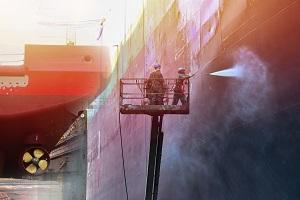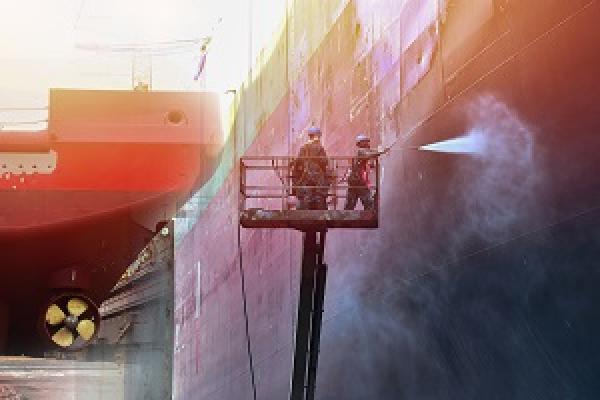
Steamship Mutual
Published: June 14, 2018

This article covers an important change to regulations relating to hull biofouling in New Zealand. It explains the regime and findings from the first few weeks of its mandatory operation.
On 15 May 2018 the Craft Risk Management Standard (CRMS) came into force. CRMS sets out the requirements for management of biofouling risks associated with ships entering New Zealand Territorial Waters (within the 12nm limit). CRMS is monitored and implemented by the Ministry for Primary Industries (MPI). In the preceding four years, MPI operated a voluntary “clean hull” protocol which has seen some ships being found to have unclean hulls on inspection and in some cases ordered out of New Zealand Territorial Waters for cleaning. As of 15 May 2018 the CRMS became mandatory. Ships which do not comply with the CRMS risk being ordered to leave New Zealand ports and New Zealand Territorial Waters.
At a recent briefing given by MPI, the point was made very strongly that the recently elected Government in New Zealand, which has the Green Party of New Zealand as one of its coalition components, intends to set a high bar on biosecurity risks. The importance of ship operators having in place measures to ensure a clean hull prior to the ship’s arrival in New Zealand was stressed.
The CRMS regime
CRMS draws a distinction between short-stay vessels and long-stay vessels with different fouling requirements for each category. A short-stay vessel is a ship in New Zealand 20 days or less and only visiting designated “places of first arrival” (which include all the main ports). Deep sea international trading ships will usually fall within the short-stay vessel category and are the focus of this article.
Full details of the CRMS can be found at the MPI website at https://www.mpi.govt.nz, www.mpi.govt.nz/document-vault/11668, www.mpi.govt.nz/importing/border-clearance/vessels/biofouling-management/.
In summary, CRMS specifies that operators must take measures to ensure a clean hull before the ship arrives in New Zealand Territorial Waters through either:
- Cleaning the hull less than 30 days before arrival;
- Having evidence of continual maintenance of the hull using best practice; or
- Booking an appointment to haul out a vessel at a MPI-approved facility or carrying out in water cleaning/treatment within 24 hours of arrival at port in New Zealand.
However, in relation to the third option above, MPI advise there is currently no available haul out facility which can take deep sea trading ships (ie. vessels > 120m length). Also, there is no approved in water hull cleaning/treatment system and this will be the case for the foreseeable future. This means that the option of cleaning/treatment within 24 hours of arrival is not currently available to a ship operator. Compliance with CRMS must be established through options 1 or 2 above.
To demonstrate compliance, ships will need to carry on board and be able to present to an MPI inspector on arrival
- An antifouling certificate and a biofouling management plan. The antifouling certificate will need to show details of the antifoul coating, the application date, the type of anti-fouling and confirmation of application of the anti-fouling to niche areas. These niche areas are of particular concern to MPI, being more difficult to clean than flat hull surfaces.
- Reports from the most recent hull and niche area cleaning.
- Records of contingency planning on clean hulls.
- A biofouling management plan.
- A biofouling record book.
So far as record keeping is concerned MPI will expect to see reports from recent hull and niche area inspections including date stamped photographs and/or video.
When it comes to what is best practice in this area MPI refers to the IMO’s biofouling guidelines. In the event that a ship is not compliant with CRMS, MPI will consider how likely it is that:
- the organisms found on the hull will reproduce.
- the organisms will be displaced from the vessel.
- the organisms or their offspring will survive and establish.
In the event of non-compliance, it is likely that the ship will be ordered to leave port and New Zealand Territorial Waters and not re-enter until hull cleaning has occurred. It still needs to be decided where a ship can carry out in water hull cleaning outside New Zealand Territorial Waters (ie. in the EEZ, 12-200nm). In the examples mentioned below the ship left New Zealand for the Pacific Islands. Once the ship has cleaned it is entitled to present itself for reinspection but MPI would expect to receive complete details of the cleaning along with photographic or video evidence of the condition of the hull.
Examples of MPI action:
- A cable laying ship, which, prior to coming to New Zealand, had spent some months in tropical waters was directed to leave New Zealand Territorial Waters for cleaning. In that case, the hull was heavily infested with unwanted organisms.
- A bulk carrier was discharging cargo at a New Zealand port. MPI ordered the ship to leave New Zealand Territorial Waters for cleaning. The ship was refused permission to enter ports in other South Pacific Islands for cleaning. Cleaning was eventually undertaken by a team of divers from New Zealand in international waters off Fiji at considerable cost.
- A bulk carrier was declined permission to load cargo. The vessel left for hull cleaning elsewhere in the Pacific.
Correspondents Comment
We understand that New Zealand is the first jurisdiction in which such stringent and compulsory biofouling measures have been introduced. MPI accepts that there will be cases which fall into a grey area as to whether a hull is dirty or clean and have said that they will work with the operator in that case. It is however important that owners/operators should familiarise themselves with the CRMS and the potentially serious operational and financial impact which failure to comply can have. It is important that owners prepare both operationally and from a documentary perspective, so that they present not only a clean hull when their ship arrives in New Zealand, but also comprehensive documentary evidence as to steps taken to comply with the CRMS.
As correspondents, we have experience with these issues and have good contacts in MPI in this area. They have indicated that they are happy to discuss the detail of the CRMS further both in a general sense and with respect to any particular ship which may arrive in New Zealand. MPI has its methods of intelligence gathering to indicate if a ship may constitute a high risk of being unclean. Owners/operators of ships should assume that MPI will be vigilant and are likely to know whether a ship has, for example, been laid up for an extended period in tropical waters.
Summary
The primary objective of CRMS is that a ship has a clean hull before arrival in New Zealand Territorial Waters. This can be met by either of the options referred to above. The other option of haul out (for vessels > 120m) or in water hull cleaning within 24 hours of arrival at port in New Zealand is not currently available.
Where there is contravention of CRMS, the remedy exercised by MPI has been to order the ship to leave port and New Zealand Territorial Waters for cleaning and provide evidence of cleaning on return. Prosecution is available to MPI under the legislation. MPI advise that as it is early days for CRMS, prosecution has not been considered as yet.
Owners and charterers may wish to consider whether to insert a specific clause dealing with hull cleaning for New Zealand or generally (if other countries implement similar rules) in charterparties.
CRMS is a new and developing regime in New Zealand. This article is a summary and for general information only. Please contact the Club or correspondents P&I Services of Auckland for advice on specific issues.
Article by Alistair Irving and Michael McCarthy
P&I Services Ltd, Auckland


